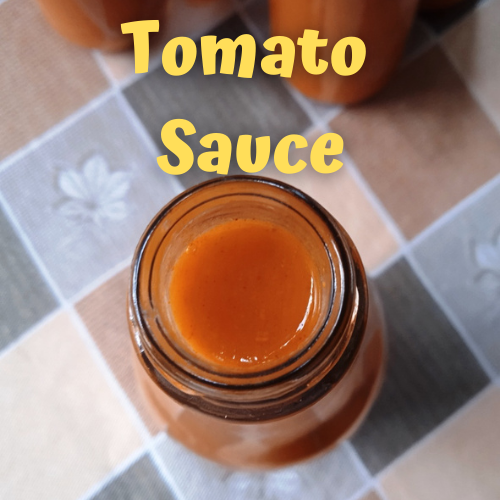
Greetings to all my beautiful Plant Power (Vegan) community. Today I wanted to share with all of you a recipe, which is common in Venezuela this season, such as TOMATE SAUCE. It should be noted that tomatoes generally bloom in December, the month in which that the temperatures drop, allowing the flowers to be born with an optimal morphology to self-fertilize. The rest of the year, the flowers that emerge in a large percentage are unviable; that is why the harvest that occurs from February to April is very abundant, and you have to take advantage of it.
Saludos a toda mi hermosa comunidad Plant Power (Vegan). Hoy he querido compartir con todos ustedes una receta, que en esta temporada es común en Venezuela, como es la SALSA DE TOMATE. Cabe señalar que el tomate, por lo general, florece en diciembre, mes en el que las temperaturas bajan, permitiendo que las flores nazcan con una morfología óptima para autofecundarse. El resto del año, las flores que emergen en un gran porcentaje son inviables; por eso es que la cosecha que se produce de febrero a abril es muy abundante, y hay que aprovecharla.
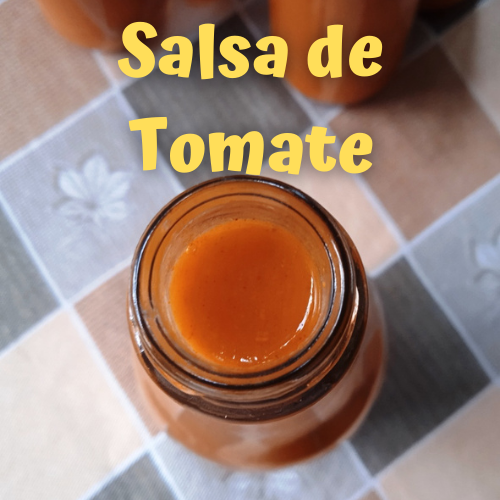
Being that we are in the tomato harvest season, this means that its price will drop and it will be much more affordable than in other months; which is why it is necessary to take advantage of and prepare a large quantity of sauce, to ensure supply throughout the year. For example, the week before, I bought 6 kilograms of good quality tomatoes for $2.50. This recipe that I am bringing you today was taught to me by my mother, and it has a peculiarity, a trick, or a tip that she in turn learned from a lady who was Italian, an emigrant from World War II, who arrived in our country from Europe, and brought with it its customs and techniques. My mother learned, and in turn taught me. Let's see this delicious récipe.
Siendo que estamos en temporada de cosecha de tomates, esto implica que baje su precio y sea mucho más asequible que en otros meses; razón por la cual es preciso aprovechar y preparar una gran cantidad de salsa, para asegurarnos el suministro durante todo el año. Por ejemplo, la semana antepasada compré 6 kilogramos de tomates de buena calidad en 2.5$. Esta receta que hoy les traigo, me la enseñó mi madre, y tiene una particularidad, un truco, o tip que ella a su vez aprendió de una señora que era italiana, una emigrante de la Segunda Guerra Mundial, que arribó a nuestro país desde Europa, y trajo consigo sus costumbres y técnicas. Mi madre aprendió, y a su vez me enseñó a mí. Veamos esta deliciosa receta.

THE RECIPE / LA RECETA
Time, ingredients and equipment
- Preparation time: For me it is imprecise, because I made this recipe in two days, I elaborated it calmly, but yes, it takes time, I think that to make it in one day the whole process would involve 6 hours approximately.
- Servings: From this amount of ingredients I obtained 7 liters of good quality tomato sauce, (although I left 1 liter unbottled, that day I prepared a large amount of spaghetti).
- 4 kilos of ripe pear tomatoes (the riper the better).
- 500 grams of onion.
- 150 grams of carrots.
- 2 heaped tablespoons of capers.
- 250 grams of olives with stone, (we subtract 50 grams of the seeds). I like olives with stone, because the stuffed ones, in my opinion, lack flavor.
- 60 grams of garlic (1 large head).
- 250 grams of sugar (this varies according to the degree of ripeness of the tomato, so it can be less or more). Here I took a little license and used white sugar, as the flavor with brown sugar varies.
- One tablespoon of sweet cloves.
- Fresh basil to taste (I used a sprig of basil).
- Salt to taste (I used 3 heaping tablespoons).
- Ground oregano to taste (I used one heaping tablespoon).
- Ground cumin to taste (I used a level tablespoon).
- 120 ml of corn oil (it can be any oil you have, for example olive or soy).
- 3 liters of water to boil the tomatoes at the beginning.
- Enough water to wash the tomatoes and do the other cooking processes.
- A wide pot, if it is made of stainless steel or cast iron, the better.
- Knife, chopping board, plates, large bowl, strainer, ladle (sterilized), funnel (sterilized), teaspoons, etc.
- Sterilized glass jars to store the sauce.


Tiempo, ingredientes y equipo
- Tiempo de preparación: Para mí es impreciso, pues hice esta receta en dos días, la elaboré con calma, pero sí, lleva su tiempo, creo que de hacerla en un día todo el proceso implicaría 6 horas aproximadamente.
- Raciones: De esta cantidad de ingredientes obtuve 7 litros de salsa de tomate de buena calidad, (aunque dejé sin embotellar 1 litro, ese día preparé una gran cantidad de spaguettis).
- 4 kilos tomates tipo perita, maduros (mientras más maduros, mejor).
- 500 gr de cebolla.
- 150 gramos de zanahoria.
- 2 cucharadas colmadas de alcaparras.
- 250 gr de aceitunas con hueso, (restamos 50 gamos de las semillas). Me gustan las aceitunas con hueso, porque las rellenas a mi parecer, carecen de sabor.
- 60 gr de ajo (1 cabeza grande).
- 250 gramos de azúcar (esto varía de acuerdo al grado de madurez del tomate, así que puede ser menos o más cantidad). Aquí me tomé una pequeña licencia y utilicé azúcar blanca, ya que el sabor con azúcar morena varía.
- Una cucharada de clavos dulces.
- Albahaca fresca al gusto (yo utilicé una rama de albahaca).
- Sal al gusto (utilicé 3 cucharadas colmadas).
- Orégano molido al gusto (utilicé una cucharada colmada).
- Comino molido al gusto (utilicé una cucharada rasa).
- 120 ml de aceite de maíz (puede ser cualquier aceite del que dispongas, por ejemplo de oliva o de soya).
- 3 Litros de agua para hervir los tomates al inicio.
- Agua suficiente para lavar los tomates y hacer los otros procesos de cocción.
- Una olla amplia, si es de acero inoxidable o hierro colado, mejor.
- Cuchillo, tabla de picar, platos, bol grande, colador, cucharón (esterilizado), embudo (esterilizado), cucharillas, etc.
- Frascos de vidrio esterilizados para almacenar la salsa.

THE PROCEDURE / EL PROCESO
The first thing we will do is wash the tomatoes, since they obviously have some dirt on them, as well as rinse the olives and capers, because as you can see they have salt and vinegar, since they come pickled, and it is very important to remove the saltiness and acidity, since otherwise the flavor of the recipe is altered; To do this, they can be left to soak for about two hours and then rinsed very well.
Lo primero que haremos será lavar los tomates, ya que obviamente tienen cierta suciedad, así como enjuagar las aceitunas y alcaparras, porque como pueden ver tienen sal y vinagre, ya que vienen encurtidas, siendo muy importante quitarles lo salobre y lo ácido, pues de lo contrario se altera el sabor de la receta; para ello se pueden dejar en remojo unas dos horas y luego enjuagar muy bien.
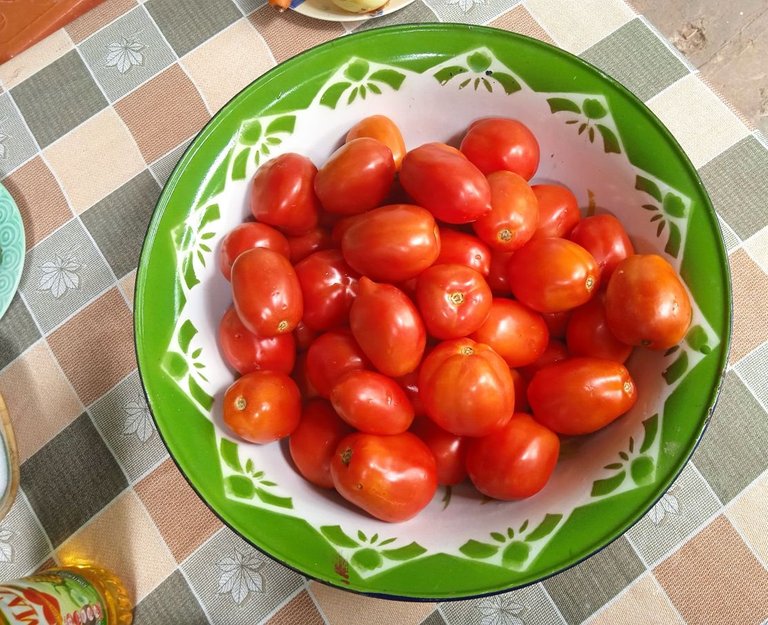
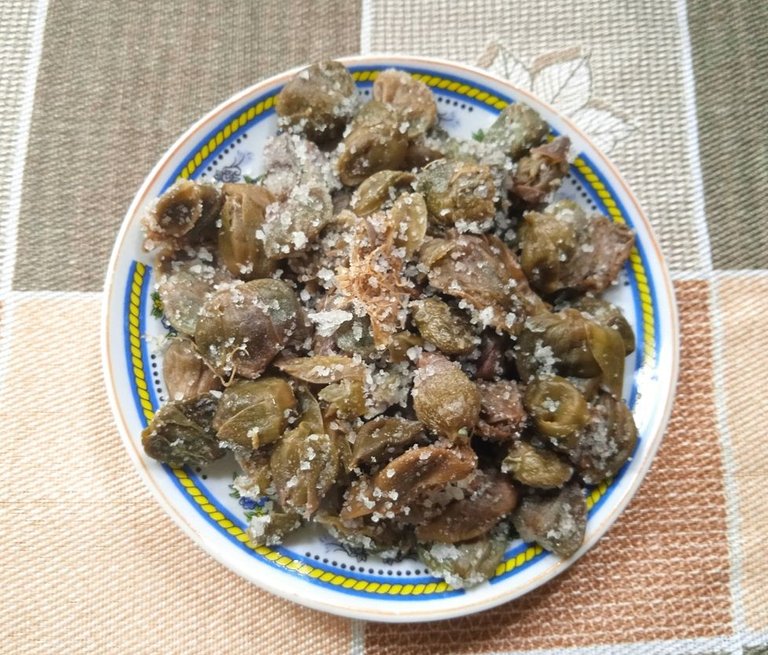
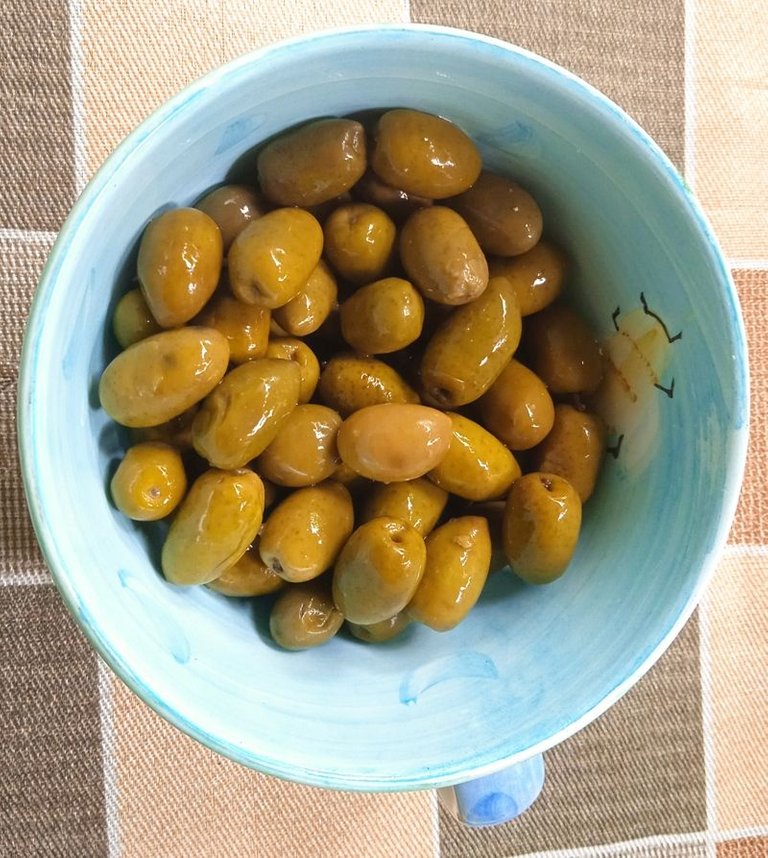

We proceed to make a cross cut at one end of each tomato. I usually do it on the back, as my mom taught me, however this time I wanted to vary and I did it on the end that connects with the plant, and I really do not recommend it because it is more difficult to remove the skin later. After the cut, I put them to cook with three liters of water for about 5 minutes (after the boiling point). After this time, I turned off the heat and waited for them to reach room temperature. Once cool, I proceeded to remove the skin, and crush them with a mashed potato. I reserved the cooking water. The skins were eaten by Mr. Morrocoy's mother, nothing is lost here, hahahaha.
Procedemos a hacer un corte en cruz, en un extremo de cada tomate. Generalmente lo hago en la parte trasera, tal como me enseñó mi mamá, sin embargo esta vez quise variar y lo hice en el extremo que conecta con la planta, y realmente no se los recomiendo pues es más difícil luego retirar el hollejo. Luego del corte, los puse a cocinar con tres litros de agua por unos 5 minutos (luego del punto de hervor). Pasado este tiempo, apagué el fuego y esperé a que alcanzaran temperatura ambiente. Una vez frescos, procedí a retirar la piel, y a aplastarlos con un pisa puré. Reservé el agua de la cocción. Los hollejos se los comió la mamá del Sr. Morrocoy, aquí nada se pierde, jajajaja.




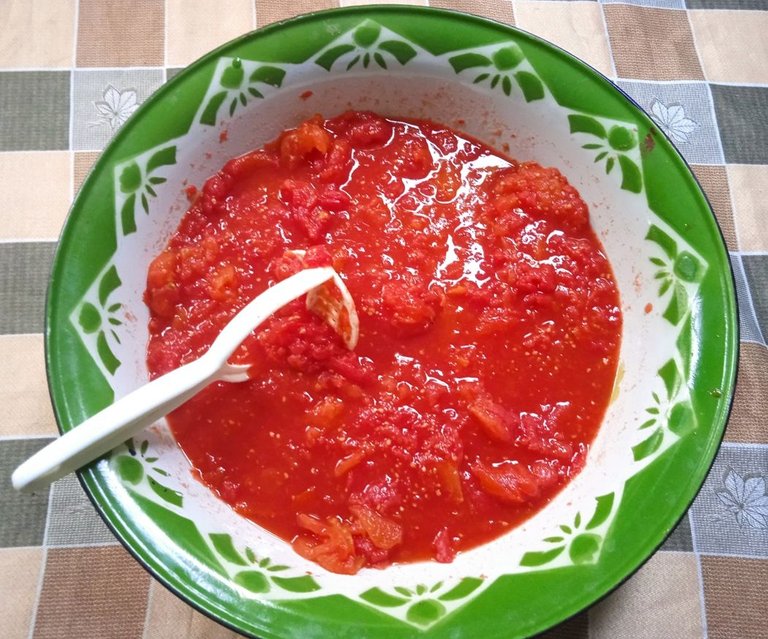

While I was waiting for the tomatoes to cool down, I diced the carrot, it is also valid to grate or chop it as you like, since it will liquefy later. I proceeded to rinse and drain the olives and capers very well, and then chop them. As I mentioned, I removed the pit from the olives, I know it's more work, but they taste better than buying them already stuffed or pitted. I also peeled and chopped the garlic (they can be crushed if they wish), and I peeled the onions and then inserted sweet cloves into their surface. And this is precisely the tip that my mom learned from the lady who emigrated from Italy, because it is this technique that gives the sauce a special touch. The sweet clove permeates the interior of the onion with its aromas and flavors, which will then be transferred to the sauce. It is important to count how many sweet cloves we have inserted in each onion, since we will later remove them, an excess of this species can ruin the sauce. I inserted between 7 and 9 cloves into each onion.
Mientras esperaba a que se enfriaran los tomates, piqué en cuadritos la zanahoria, también es válido rallarla o picarla como gusten, ya que posteriormente se licuará. Procedí a enjuagar y escurrir muy bien las aceitunas y alcaparras, para luego picarlas. Como comenté, a las aceitunas les extraje el hueso, sé que es más trabajo, pero tienen mejor sabor así que comprarlas ya rellenas o deshuesadas. Igualmente pelé y piqué los ajos (pueden aplastarse si así lo desean), y pelé las cebollas para luego insertarles clavos dulces en su superficie. Y es este precisamente el tip que aprendió mi mamá de la señora que emigró de Italia, pues es esta técnica la que le da un toque especial a la salsa. El clavo dulce impregna el interior de la cebolla con sus aromas y sabores, lo que luego se transferirá a la salsa. Es importante contar cuántos clavos dulces hemos insertado en cada cebolla, ya que luego los retiraremos, un exceso de esta especie puede arruinar la salsa. Yo inserté entre 7 y 9 clavos a cada cebolla.
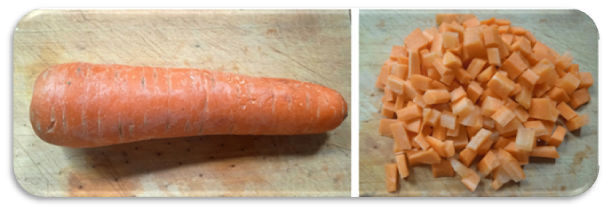

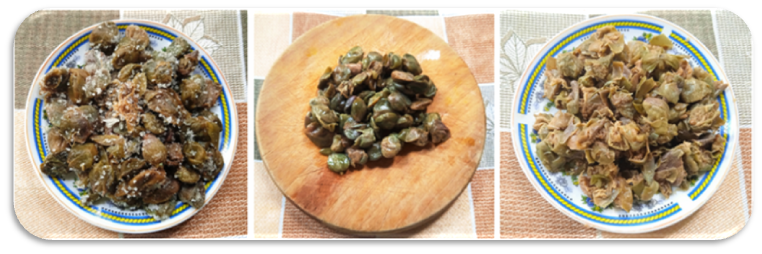



Once everything is ready, I proceed to fry the garlic in hot oil. Next I add the carrot while I stir so that they fry evenly. Later I place the onions with the sweet cloves inside the pot so that they are sautéed, for which I must go around with the palette, in this way the sweet cloves release even more the aromas due to the heat. In this case, I did not fry the onions very much, because this sauce was for sale, and perhaps a very pronounced flavor of this species would not be pleasant for the consumer; but when it is for home consumption, I brown the onions more, it is up to each person how intense they want their flavor. After the onions, I add the olives and capers and continue stirring so that they are fried.
Una vez teniendo todo listo, procedo a sofreír el ajo en aceite caliente. A continuación incorporo la zanahoria mientras remuevo para que se sofrían uniformemente. Posteriormente coloco las cebollas con los clavos dulces en el interior de la olla para que se vayan sofriendo, para lo cual debo ir dando vueltas con la paleta, de esta manera el clavo dulce libera aún más los aromas por el calor. En este caso no sofreí mucho las cebollas, pues esta salsa era para la venta, y quizás un sabor muy pronunciado de esta especie, no sería agradable al consumidor; pero cuando es para consumo de casa, doro más las cebollas, queda a criterio de cada quien cuán intenso desea su sabor. Luego de las cebollas, incorporo las aceitunas y alcaparras y sigo removiendo para que se sofrían.



Once the onions are already fried, I remove them from the pot, wait for them to cool down a bit, and remove the sweet cloves, for which it is important to count them, because as I already mentioned, if a single nail escapes, it could alter the taste of the sauce. I chop the onions and return them to the pot, stirring so that they finish frying. After this procedure, I add the pureed tomatoes, stirring to mix with the other ingredients. I add the cooking water that I had previously reserved, and I place bay leaves, which as you can see in this case there are five, since there is a belief that if we use the leaves in even quantities the sauce will become bitter (it is also a belief Italian). I also add a branch of fresh basil, which does not appear in the first photos, because my husband went to my mother-in-law's house to look for it, because my plants withered. I also add the ground sugar, salt, oregano and cumin to the mixture. I stir, cover, lower the flame to a minimum and let it cook for approximately two and a half hours, during which time the flavors will amalgamate and the liquid will reduce.
Una vez que las cebollas ya están fritas, las saco de la olla, espero que se enfríen un poco, y retiro los clavos de olor, para lo cual es importante contarlos, porque como Ya lo mencioné, si se escapa un solo clavo, podría alterar el sabor de la salsa. Troceo las cebollas y las devuelvo a la olla, removiendo para que terminen de freírse. Después de este procedimiento, agrego los tomates triturados, revolviendo para que se mezclen con los demás ingredientes. Añado el agua de cocción que había reservado previamente, y coloco hojas de laurel, que como podéis ver en este caso son cinco, ya que existe la creencia de que si usamos las hojas en cantidades pares la salsa se vuelve amarga, (es es también una creencia italiana). Igualmente le agrego una rama de albahaca fresca, que no sale en las primeras fotos, porque mi esposo fue a casa de mi suegra a buscarla, ya que se me marchitaron mis plantas. También agrego el azúcar molido, la sal, el orégano y el comino a la mezcla. Remuevo, tapo, bajo el fuego al mínimo y dejo que se cocine durante dos horas y media aproximadamente, tiempo durante el cual se amalgaman los sabores y se reduce el líquido.




After this time, I remove the pot from the heat and wait for its contents to cool down, to later extract the bay leaves, (which I will count, because if I blend them it can change the flavor of the sauce) and the basil branch. I proceed to blend and strain in order to remove the seeds from the tomato. All these remains will also later go to the tribe of Mr. Morrocoy. I put the sauce obtained back in the pot and cook it for about an hour, over low heat so that it reduces the liquid even more and acquires a firmer consistency. At this stage I can rectify salt, sugar and spices. Once this process is finished, I proceed to bottle it, for which I use a metal ladle and a funnel, also metal, which I previously sterilized by means of a long boil. It should be noted that this pewter funnel in the photo is 100 years old and belonged to my great-grandmother and I use it as a way to connect with my roots.
Transcurrido este tiempo, retiro la olla del fuego y espero a que se enfríe su contenido, para posteriormente extraer las hojas de laurel, (las cuales contaré, porque si las licúo puede cambiar el sabor de la salsa) y la rama de albahaca. Procedo a licuar y colar a fin de retirar las semillas del tomate. Todos estos restos también irán posteriormente a la tribu del Sr. Morrocoy. La salsa obtenida la coloco nuevamente en la olla y la cocino por aproximadamente una hora, a fuego bajo para que reduzca aún más el líquido y adquiera una consistencia más firme. En esta etapa puedo rectificar sal, azúcar y especias. Finalizado este proceso, procedo a embotellarla, para lo cual me ayudo de un cucharón metálico y un embudo, también metálico, a los que previamente esterilicé mediante un largo hervor. Cabe señalar, que este embudo de peltre de la foto, tiene 100 años de antigüedad y era de mi bisabuela y lo utilizo como una forma de conectar con mis raíces.




From all this mixture I obtained seven liters in total, six of which I bottled in sterile jars. I did not pass the bottles through boiling water again to make the sterilization process more effective, because the sauce had already been ordered and I knew that it would be consumed immediately, however, it is highly recommended once the sauce is bottled, proceed to boil the bottles already covered, stand in a large pot, for 30 minutes and let it cool naturally. This ensures greater preservation of the content.
De toda esta mezcla obtuve siete litros en total, seis de los cuales embotellé en frascos estériles. No volví a pasar las botellas por agua hirviendo para hacer más efectivo el proceso de esterilización, porque la salsa ya había sido encargada y sabía que iba a ser consumida de inmediato, no obstante, es muy recomendable una vez embotellada la salsa, proceder a hervir las botellas ya tapadas, de pie en una olla amplia, por espacio de 30 minutos y dejar que se enfríe al natural. Esto asegura una mayor preservación del contenido.
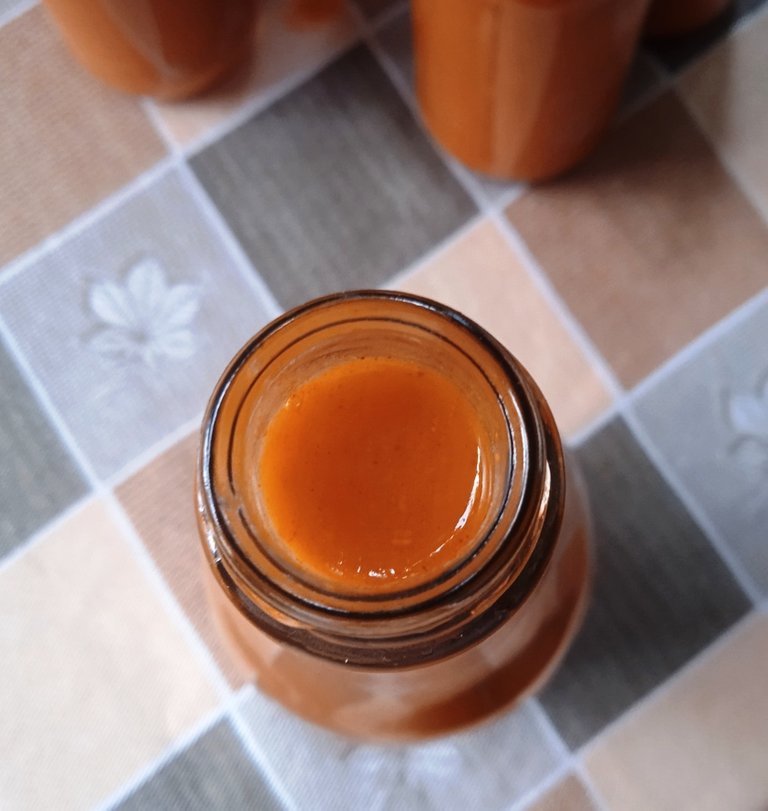
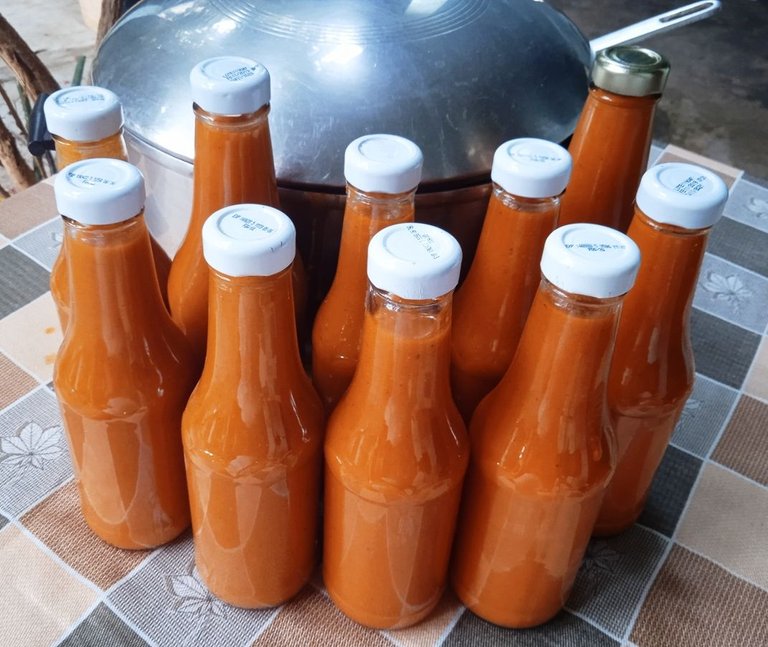

Aquí termino mi post de hoy, del que sinceramente estoy muy contenta de haberlo hecho, a fin de compartir con todos ustedes esta receta familiar. Los invito a que aprovechen la temporada de tomates en sus respectivos países y preparen muchos litros de esta salsa, así siempre tendrán en sus alacenas esta delicia.

These photos are my own, and were taken with a Xiomi REDMI 8 A phone
The dividers used are courtesy of @eve66 who shares beautiful designs that embellish the layout of our post.
In case it is required to use the content or images of this post and of my other publications, I would appreciate if you could refer to my authorship (Fabiola Martínez) and cite the corresponding link. Thanks.



Would you believe that I have NEVER made tomato sauce! Of all my recipes. Raw and cooked I have made tomato paste - raw with dehydrated tomatoes - of course. But never tomato sauce. I LOVE your recipe. With capers and olives it is a winner @sirenahippie!
Wow, this is really surprising, because I know you grow and harvest a lot of vegetables on your farm. Try making this sauce when you have tomato crops, I assure you it will turn out great, you can even make any changes you see fit to the recipe. And yes, the olives and capers add a unique flavor. Cheers.
Wow que cantidad de salsa!! 😋🤗
Hola @sirenahippie que receta tan completa y diferente a la que generalmente se prepara; las aceitunas, alcaparras y laurel me imagino aportan un gran sabor.
6 kilos de tomate por ese precio es una gran oferta (una ganga ja, ja), se aproxima la segunda temporada de cosecha y promete buenos precios debido a la abundancia de tomates que habrá en el mercado.
La preparación de la salsa requiere dedicación y tiempo, pero creo que el resultado vale la pena, para disfrutar una deliciosa salsa con pasta, tostones, papas fritas y más.
Muy tierna mamá morrocoy 🤗, en casa tenemos una y son una ternura 🐢.
Gracias por compartir la receta de tu mamá, me gustó mucho por la variedad de ingredientes texturas y sabores que se integran en la salsa.
Bendiciones!
Hola @belkyscabrera, pensé en responderte ayer y la energía eléctrica me traicionó en el momento en que lo iba a hacer. Muchas gracias por tu visita a mi post. Sí, es cierto, la salsa requiere dedicación porque es una receta que al hacerla en grandes volúmenes para que sea rendidora y dispongamos de varias raciones los siguientes meses.
Sí, los morrocoyes son súper tiernos y longevos, yo debo tener alrededor de 30 entre el solar y la guardería, además de que son animales que ayudan a descomponer los restos vegetales, útiles para los espacios verdes.
Gracias por la visita. Saludos.
Oh, tienes bastante morrocoyes @sirenahippie, me imagino el solar con ellos caminando, comiendo y haciendo sus cuevas. 🐢.
Saludos y feliz sábado.
Ya se me hacía raro que el precio del tomate bajara tanto, cuando en semanas pasadas estaba muy costoso.
Admiro a las personas que tienen ese gusto y capacidad de pasar tanto tiempo en la cocina, es algo con lo que lucho a diario, no es mi fuerte, supongo que tantas ocupaciones me estresan y por eso no paso mucho tiempo en la cocina por lo más rápido, pero si algo estoy segura es que una comida bien hecha y rica como una buena pasta con esta salsa lleva su tiempo y de vez en cuando valdría la pena hacerla.
Saludos.
Hola @mirel0510, muchas gracias por tu visita a mi blog. Sí, la zafra debe estar por finalizar, por eso es preciso aprovechar los buenos precios. La cebolla también está en temporada de cosecha, ella puede aprovecharse de múltiples formas. Quizás comparta un modo de procesarla para tener disponible su sabor el resto del año.
Con respecto a tu apreciación de la cocina, es como todo, no es obligante que te guste; por ejemplo, para mí es una tortura lavar, sin embargo conozco personas, como mi madre, que les encanta hacerlo. Todo es relativo. En tu caso, te recomendaría te decantaras por platos sencillos, tratando de elaborar grandes cantidades de comida para que la refrigeres y así te facilites la rutina diaria. Cocinar un kilo de granos (caraotas, frijoles, lentejas, quinchonchos) y luego dividirlo en porciones, aligera la carga del día a día. Espero que en alguna oportunidad te motives a elaborar mi receta y luego me cuentes cómo te quedó.
Saludos.
Eso espero, la verdad es que me gusta mucho la pasta y es una lastima que no me quede tan buena si no tiene una salsa como está.
Saludos.
I've never tried making tomato sauce or paste from scratch. We usually buy ready-made ones... but this would be awesome to try especially because a lot of food in my country (the Philippines) uses tomato sauce as base... :)
Sometimes I buy ketchup and industrially processed tomato paste, but I like to make the most of the tomato season, as for me it is a fundamental ingredient in the kitchen. You can try to make this recipe, and even make any variations you consider necessary. Thank you very much for reading and commenting. Greetings.
Genial, saludosGrandiosa receta @sirenahippie , creo que vale la pena el esfuerzo y tiempo invertido, además el ahorro qué representa tenerla lista y hecha en casa.
Hola, que buena tu visita @miriam11, gracias por pasar a leer y comentar. Ciertamente lleva cierto trabajo, pero el resultado es genial, y el disponer de una salsa con gran sabor y natural, no tiene precio. Saludos.
seeing tomatoes that are so tiny, I'm so interested in making spicy and sweet pickled tomatoes, thank you @sirenahippie for giving me such a great idea 😍
Ohhh, that idea will be great, they sure are delicious. In Venezuela we call this variety of tomatoes "perita" because of their shape. Thanks for the visit @umirais.
you are welcome @sirenahippie 💖
I'm doing something similar, we put eggplant in it. In Macedonia it is called Lutenitsa and is used as a breakfast sauce. Bon appetit, good luck
How interesting about breakfast! I usually prepare it with various vegetables, I use it to stew potatoes, cabbage, eggplant, zucchini, sweet peppers and it is delicious like this. Thank you very much for your visit and comment. Greetings.
I love breakfast, so I make special things for breakfast. This sauce is one of the special dishes. You are making it healthy and with vitamins, bravo 👏👏😋
Congratulations @sirenahippie! You have completed the following achievement on the Hive blockchain and have been rewarded with new badge(s):
Your next target is to reach 5000 replies.
You can view your badges on your board and compare yourself to others in the Ranking
If you no longer want to receive notifications, reply to this comment with the word
STOPCheck out the last post from @hivebuzz:
Support the HiveBuzz project. Vote for our proposal!
Se ve muy sabrosa.. para una pizza o un pasticho 😍😍 yo hoy no conseguí tomates lindos, creo que están arrasando con los tomates.
Ya está cesando la cosecha @kyleana, pero aún se consiguen a buenos precios, y realmente importa poco que sean bonitos o no. En donde resido he visto a la gente de la colonia italiana, llevándose los tomates más pasados, más maduros, pues estos son ideales para la salsa. Gracias por tu visita a mi post. Saludos.
Tomatoes in Venezuela is quite cheaper than in Thailand, probably 2-3 times cheaper! 😃I never try to make potato sauce before, it's seem easy and look delicious. Thanks for sharing and inspired me to have more fun recipe for cooking in the future.💜
Hi @shinecrystalline! Thank you for your visit to my post. Tomatoes are not cheap all the time, only at harvest time, during the first quarter of each year. Venezuela is a hot country, so it is difficult to produce other months of the year, so I always take advantage, both tomatoes, onions and eggplants, because it is the time of the year.
I hope this recipe that my mother taught me, will be useful for your good dishes. Greetings.
Realizare tu receta de salsa de tomate, debe de quedar con un sabor único, ese toque de aceituna y alcaparra es inigualable. Gracias por compartir.@sirenahippie, saludos.
Hola @panmonagas, muchas gracias por tu visita. Sí, esta salsa queda muy buena, claro, la que se hace con menos ingredientes también es deliciosa. El domingo preparé 10 litros y pensé que la había estropeado porque se me fue un clavo dulce, pero realmente perdió luego el aroma, no obstante, hay que ser cuidadosos y no licuar ni el laurel, ni la albahaca y menos los clavitos. Espero que te quede muy buena. Saludos.
Si con esa lluvia de perfume que le dan las especies y hierbas no dudo lo deliciosa que debe de quedar la salsa.Gusto en saber de ti @sirenahippie.
Ohhh, thanks for stopping by to read my recipe @ettydiallova. Yes, I usually eat it with pasta and homemade pizza. I also make it with lots of veggies: potatoes, zucchini, eggplant, cabbage, sweet peppers, it looks great that way. I hadn't thought about the crackers, it can be an interesting combination, I'll try it and then I'll tell you about it. Cheers!